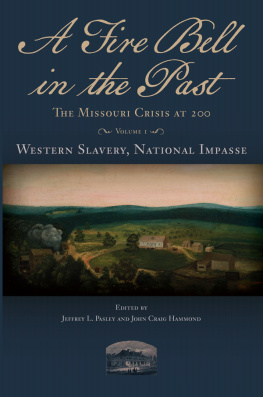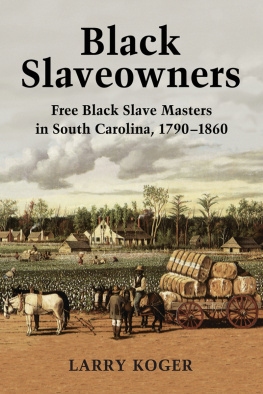ON SLAVERYS BORDER
Early American Places is a collaborative project of the University of Georgia Press, New York University Press, and Northern Illinois University Press. The series is supported by the Andrew W. Mellon Foundation. For more information, please visit www.earlyamericanplaces.org.
ADVISORY BOARD
Vincent Brown, Harvard University
Stephanie M. H. Camp, University of Washington
Andrew Cayton, Miami University
Cornelia Hughes Dayton, University of Connecticut
Nicole Eustace, New York University
Amy S. Greenberg, Pennsylvania State University
Ramn A. Gutirrez, University of Chicago
Peter Charles Hoffer, University of Georgia
Karen Ordahl Kupperman, New York University
Joshua Piker, University of Oklahoma
Mark M. Smith, University of South Carolina
Rosemarie Zagarri, George Mason University
ON SLAVERYS BORDER
Missouris Small-Slaveholding Households, 18151865
DIANE MUTTI BURKE
2010 by the University of Georgia Press
Athens, Georgia 30602
www.ugapress.org
All rights reserved
Printed digitally in the United States of America
Sections of reprinted from Searching for their Places: Women in the South Across Four Centuries, edited by Thomas H. Appleton, Jr., and Angela Boswell, by permission of the University of Missouri Press. Copyright 2003 by the Curators of the University of Missouri.
LIBRARY OF CONGRESS CATALOGING-IN-PUBLICATION DATA
Burke, Diane Mutti.
On slaverys border : Missouris small-slaveholding households, 18151865 / Diane Mutti Burke.
p. cm. (Early American places)
Includes bibliographical references and index.
ISBN-13: 978-0-8203-3636-7 (hardcover : alk. paper)
ISBN-10: 0-8203-3636-X (hardcover : alk. paper)
ISBN-13: 978-0-8203-3683-1 (pbk. : alk. paper)
ISBN-10: 0-8203-3683-1 (pbk. : alk. paper)
1. SlaveryMissouriHistory19th century. 2. SlaveholdersMissouriHistory19th century. 3. HouseholdsMissouriHistory19th century. 4. Farm lifeMissouriHistory19th century. 5. SlavesMissouriSocial conditions19th century. 6. African AmericansMissouriSocial conditions19th century. 7. WhitesMissouriSocial conditions19th century. 8. MissouriRace relationsHistory19th century. 9. MissouriSocial conditions19th century. 10. Border States (U.S. Civil War)Social conditionsCase studies. I. Title.
E445.M67B87 2010
977.803dc22
2010026523
British Cataloging-in-Publication Data available
FRONTISPIECE: County Map of the States of Iowa and Missouri. W. H. Gamble. This 1861 map of the states of Iowa and Missouri shows the location of county lines, towns, waterways, and railroads on the eve of the Civil War. This map was created by W. H. Gamble and published by S. A. Mitchell Jr. of Philadelphia. Courtesy of the State Historical Society of Missouri.
ISBN for this digital edition: 978-0-8203-3736-4
For David, Matthew, Maggie, and Ellie
CONTENTS
ACKNOWLEDGMENTS
Growing up in Kansas City, I understood that Missouri was a border state during the Civil War, and I also had a vague notion that the region was not a land of large plantations; however, I was never taught the history of slavery in the state. When choosing a topic for an undergraduate honors thesis, I decided to explore the experiences of the slaves and slaveholders who lived in my natal state. Without fully understanding it at the time, I stumbled into a historiographically significant project. I have been researching and writing on this topic ever since, and along the way I have benefited from the assistance and guidance of many wonderful individuals. I hope to thank them all, but I know that with a project spanning so many years I may inadvertently omit someone who helped me.
I have profited from wonderful advice and support from a number of professors and faculty mentors at both Dartmouth College and Emory University. Jere Daniell, Michael Green, and Margaret Darrow inspired me to learn and think about eighteenth- and nineteenth-century United States and European history, and Mary Kelley and Sydney Nathans skillfully mentored me as I wrote my undergraduate thesis. At Emory University, I benefited from sitting in the classrooms of Jonathan Prude, Margot Finn, and Susan Socolow, as well as Mary Odem, who both taught me well and served as a model for balancing teaching, scholarship, and motherhood. Dan Carter was of great assistance in the initial phase of the process, and Eugene Genovese graciously stepped in when Dr. Carter moved to another university, lending his incredible breadth of knowledge on southern slavery and society to this project. Throughout the years, James Roark has been a constant source of advice and support. He carefully read drafts of chapters and articles and has been enthusiastic about the need for a new study of Missouri slavery since we first talked of it. Finally, I am deeply grateful to Elizabeth Fox-Genovese, for her unfailing encouragement over the years. She was supportive of my decisions and she helped improve my project and encouraged me both personally and professionally in so many ways. I only wish that she could be here to witness the publication of this book.
I often learned nearly as much from my outstanding peers as I did from my professors. I benefited from lively historical debates with Dan Costello, Sarah Gardner, David Freeman, and Jeffrey Young, around both the seminar and the cafeteria table. The members of my writing group, Christine Jacobson Carter, Ellen Rafshoon, Yael Fletcher, Annette Parks, Ruth Dickens, Naomi Nelson, Stacey Horstmann Gatti, Jaclyn Stanke, and Belle Tuten, offered helpful criticisms of early drafts of chapters. Traveling with Jacki Stanke and Sarah Gardner made research road trips much more enjoyable. Steve Goodson and Ann Short Chirhart, who were further along in the process, always were sources of advice and encouragement. Good friends, Christine Carter, Ellen Rafshoon, Ruth Dickens, and Laura Crawley, shared with me the joys and frustrations of balancing graduate school and motherhood.
I deeply appreciate the History Department at the University of MissouriKansas City for giving me the opportunity to live and work in my hometown. My wonderful colleagues and students have made UMKC a wonderful place to teach, as well as research and write. I first must thank my department chairs Louis Potts and Gary Ebersole, who have been extremely supportive of my work over the past six years. In addition, Dean Karen Vorst granted me a leave from teaching during a crucial juncture in the revision process. Gail Green and Amy Brost provided amazing administrative support. Scott Walters patiently endured making multiple revisions to his maps, and graduate students Jennifer Farr, Clinton Lawson, and Chainy Folsom spent hours transcribing microfilm, tracking down documents and photographs, and double-checking my statistics and citations. My colleagues Pellom McDaniels, Louis Potts, and Linna Funk Place have served as excellent sounding boards for my ideas about nineteenth-century Missouri history. Lynda Payne, Miriam Forman-Brunell, Andrew Bergerson, Carla Klausner, Dennis Merrill, and Linda Mitchell have provided me with sound scholarly and professional advice, and James Falls, Mary Ann Wynkoop, Dave Freeman, Viviana Grieco, Shona Kelly Wray, and especially John Herron have made life in Cockefair Hall a lot more enjoyable.








